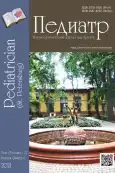Dynamics of resistance to antibiotics in nosocomial staphylococci from multidisciplinary hospital
- Authors: Gladin D.P.1, Kozlova N.S.2, Korolyuk A.M.1, Barantsevich N.E.3, Baranov I.A.2, Khairullina A.R.1, Barantsevich E.P.3
-
Affiliations:
- St. Petersburg State Pediatric Medical University
- St. Petersburg State North-Western Medical University named after I.I. Mechnikov
- Almazov National Medical Research Centre
- Issue: Vol 12, No 6 (2021)
- Pages: 43-53
- Section: Original studies
- URL: https://journals.eco-vector.com/pediatr/article/view/106322
- DOI: https://doi.org/10.17816/PED12643-53
- ID: 106322
Cite item
Abstract
Background. Staphylococci are still the leading causative agents of infections associated with healthcare, and the study of their antibiotic resistance is still relevant.
Aim. The research is aimed at study of antibiotic resistance of hospital strains of staphylococci in dynamics.
Materials and methods. Susceptibility to 16 antimicrobial agents was studied in 554 Staphylococcus strains, isolated from patients in a multidisciplinary medical centre. The method of serial microdilutions was used.
Results. Antibiotic-resistant strains prevailed (85.4%). Methicillin-resistance and multy-resistance were found to be more typical for coagulase-negative strains – 75.2% and 74.1% respectively, than for Staphylococcus aureus – 14.2% and 15.4% respectively. Methicillin-resistance and poly-resistance in S. aureus was found to decrease – it was 11.1% and 12.8% in 2015–2016 (17.1% and 17.9% respectively in 2011–2012). On the contrary, methicillin-resistance in coagulase-negative staphylococci strains during the same period increased 1.5 times. Totally, methicillin-resistant strains composed a half of the isolates – 48.7%. The studied Staphylococcus strains were susceptible to vancomycin, daptomycin, tigecycline. Resistance to linezolid and amikacin was 2.2% and 2.7% respectively. S. aureus strains were all susceptible to linezolid, fusidic acid, rifampicin, trimethoprim-sulfamethoxazole. Minimum inhibitory concentrations (MIC) of antibiotics for staphylococci varied in wide ranges from 0.06 to ≥128 mg/l. For S. aureus and S. epidermidis, the MIC50 and MIC90 of only five drugs (benzylpenicillin, tigecycline, vancomycin, linezolid, and daptomycin) were the same, while the MIC50 and MIC90 of most of the other studied drugs against S. epidermidis were significantly higher compared to S. aureus.
Conclusion. The variability of resistance of staphylococci to antimicrobial drugs in a multidisciplinary hospital confirms the need for continuous monitoring of their antibiotic resistance.
Keywords
Full Text
About the authors
Dmitry P. Gladin
St. Petersburg State Pediatric Medical University
Author for correspondence.
Email: gladin1975@mail.ru
MD, PhD, Associate Professor, Head of the Department of Microbiology, Virusology & Immunology
Russian Federation, Saint PetersburgNadezhda S. Kozlova
St. Petersburg State North-Western Medical University named after I.I. Mechnikov
Email: spbkns@gmail.com
MD, PhD, Associate Professor of the Department of Medical Microbiology
Russian Federation, Saint PetersburgAlexander M. Korolyuk
St. Petersburg State Pediatric Medical University
Email: microb3@mail.ru
MD, PhD, Dr. Sci. (Med.), Professor of the Department of Microbiology, Virusology & Immunology
Russian Federation, Saint PetersburgNatalia E. Barantsevich
Almazov National Medical Research Centre
Email: lenabara2003@inbox.ru
Junior Researcher, Research Laboratory of Nosocomial Infections
Russian Federation, Saint PetersburgIlya A. Baranov
St. Petersburg State North-Western Medical University named after I.I. Mechnikov
Email: vodolaz74@yandex.ru
Student of faculty General Medicine
Russian Federation, Saint PetersburgAlina R. Khairullina
St. Petersburg State Pediatric Medical University
Email: alinka_1614@mail.ru
Student of faculty General Medicine
Russian Federation, Saint PetersburgElena P. Barantsevich
Almazov National Medical Research Centre
Email: lenabara2003@inbox.ru
MD, PhD, Dr. Sci. (Med.), Professor, Head, Research Laboratory of Nosocomial Infections
Russian Federation, Saint PetersburgReferences
- Alekseev VV, Alipov AN, Andreev VA, et al. Medicinskie laboratornye tekhnologii. Vol. 2. Moscow: GEOTAR-Media; 2013. (In Russ.)
- Gladin DP, Hajrullina AR, Korolyuk AM, et al. Species composition and sensitivity to antibacterial drugs of staphylococci isolated from patients of a multidisciplinary children’s hospital in St. Petersburg. Pediatrician (St. Petersburg). 2021;12(4):15–25. (In Russ.) doi: 10.17816/PED12415-25
- Danilova LA, Basharina OB, Krasnikova EN, et al. Spravochnik po laboratornym metodam issledovaniya. Moscow: Piter; 2003. 733 p. (In Russ.)
- Kozlova NS, Barantsevich EP, Barantsevich NE, Goik VG. Antibiotic resistance of staphylococci isolated from blood. Nauchnoe Obozrenie. 2014;3:184–190.
- Kozlova NS, Barantsevich NE, Ivanova LV, et al. Susceptibility to antibiotics in nosocomial staphylococci from multidisciplinary hospital. Problems in Medical Mycology. 2015;17(4):58–62.
- Pestova NE, Barantsevich EP, Rybkova NS, et al. Study of the effectiveness of DNA sequencing of the 16s rRNA gene fragment for the identification of microorganisms. Preventive and Clinical Medicine. 2011;(4): 57–59.
- Romanov AV, Dekhnich AV, Sukhorukova MV, et al. Antimicrobial resistance of nosocomial staphylococcus aureus isolates in Russia: results of multicenter epidemiological study “marathon” 2013–2014. Linical Microbiology and Antimicrobial Chemotherapy. 2017;19(1):57–62.
- Rukovodstvo po meditsinskoy mikrobiologii. Kn. III, T. 1. Opportunisticheskie infektsii: vozbuditeli i etiologicheskaya diagnostika. Labinskoy AS, Kostyukovoy NN, eds. Moscow: BINOM; 2013. 752 p.
- Sbojchakov VB, Moskalev AV, Andreev VA, et al. Meditsinskaya mikrobiologiya. Saint Petersburg: VMedA; 2017. 448 p.
- Svetlichnaya YuS, Kolosovskaya EN, Kaftyreva LA, et al. Microbiological monitoring in epidemiological surveillance for hospital infections. Epidemiology and Vaccinal Prevention. 2014;(1):9–14.
- Stepanov AS, Vasil’eva NV. Widespread of Staphylococcus spp. resistance mechanisms in isolates from clinical specimens. Problems in Medical Mycology. 2016;18(3):45–48.
- Strategiya i taktika primeneniya antimikrobnykh sredstv v lechebnykh uchrezhdeniyakh Rossii. Rossiyskie Natsional’nye Rekomendatsii. Savel’eva VS, Gel’fanda BR, Yakovleva SV, eds. Moscow: BORGES; 2012. 92 p.
- Shihverdiev NN, Hubulava GG, Marchenko SP, et al. Choise of local antibacterial medications for prevention of sternal infection. Pediatrician (St. Petersburg). 2017;8(2):89–93. (In Russ.) doi: 10.17816/PED8289-93
- Antimicrobial resistance surveillance in Europe. Annual report of European Antimicrobial resistance surveillance network (EARS-net). 2015. Stockholm: ECDC; 2017. 120 p.
- Beceiro A, Tomas M, Bou G. Antimicrobial resistance and virulence: a successful or deleterious association in the bacterial world? Clin Microbiol Rev. 2013;26(2):185–230. doi: 10.1128/CMR.00059-12
- CLSI. Performance Standards for Antimicrobial Susceptibility Testing; Twenty-second information supplement. 30th edition. CLSI document M100. V.40 (1). Wayne, PA: Clinical and Laboratory Standards Institute; 2020. 332 p.
- EUCAST (2017). Guidance Document: Important considerations for breakpoint setting of antibiotic-inhibitor combinations. 2017. 4 p. Available at: https://www.eucast.org/clinical_breakpoints/
- Otto M. Staphylococcus epidermidis – the “accidental” pathogen. Nat Rev Microbiol. 2009;7(8):555–567. doi: 10.1038/nrmicro2182
- Raad I, Alrahwan A, Rolston K. Staphylococcus epidermidis: emerging resistance and need for alternative agents. Clin Infect Dis. 1998;26(5):1182–1187. doi: 10.1086/520285
Supplementary files


















